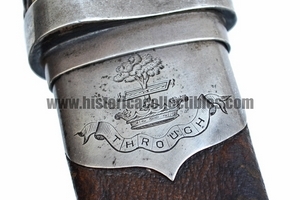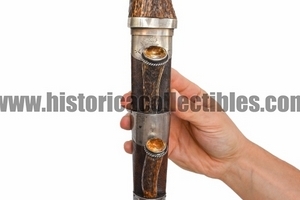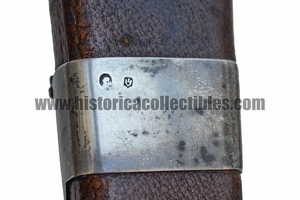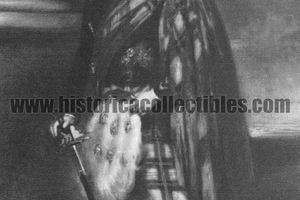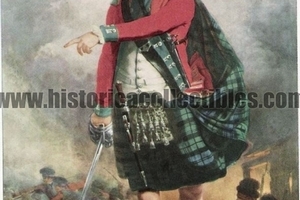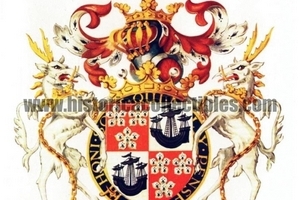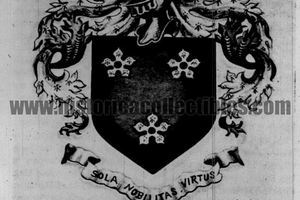Scottish Dirk Highlanders belonged to the Hamilton Clan, circa 1854
Highlanders Dirk (in Jagd Dirk version or "hunting"), made in 1854 for the Clan Hamilton, and more precisely belonged to William Archibald Alexander Hamilton (1811-1863) as was the eleventh Duke of Hamilton and Brandon eighth Duke starting from 1852 until 1863.
On Throat Fitting is engraved the blazon of arms of Hamilton consists of a fruity oak tree transversely penetrated by a saw, leaving a ducal crown. Beneath the coat of arms is engraved the "motto" of the Hamilton family "THROUGH", coat of arms, which in Scottish heraldry only the clan chief can wear.
The punches present on the silver mounts facilitate exhaustively the task to determine the lifetime and origin of this Dirk in fact it shows us exactly that this has been realized in the capital of Scotland, Edinburgh, in the period 1854-1862 (Profile Queen Victoria) and initials J.P.H. about the master silversmith.
This Dirk is mounted with silver trim, the sheath covered with brown skin is very different from Dirk used by the Scots in military parades or ceremonial functions. The handle is made of deer horn (used only on hunting pieces). The bone is made up, on top of the handle by a large smoky quartz stone set into a fine silver mount. The same stone can be found in smaller and different format to one another on both accessories such as fork and boxcutter were used during meals in the mountains and the glades. In fact, the stones and silver mounts have a very specific explanation to be found in the Scottish traditions. In fact, the stones and the use of silver was not only decorative, but tradition has it that if the highlander had been injured or died during a hunting trip, along a main road or along a secondary path, thanks to the shine of these two materials, any wayfarer would have been able to locate him even from a distance, the event would have been the reward for the assistance offered, but in case he found dead the other hand, tradition has it, would serve to pay for the funeral expenses.
Its dimensions are:
total length with sheath: 45 cm
dagger Overall length: 41 cm
Blade length: 27 cm
They are extremely rare the hunting versions of Highlanders Dirk and unobtainable those belonging to important Scottish chef clans.
An exceptionally condition.
Hamilton clan:
The Hamilton clan was an ancient Scottish clan, with extensive holdings in central and southern Scotland, particularly in Ayrshire, Lanarkshire and the Lothians. The Hamiltons' main area of influence was the Lowlands.
The Hamilton family, according to tradition, descends from the Beaumont family, a branch of which owned a castle in Hamilton, Leicestershire; in the Hamilton coat of arms the three cinquefoils derive from the single cinquefoil of the Beaumont coat of arms.
The first person belonging to the family and identifiable in the documents was William Fitz Gilbert, remembered in a charter of 1294-1295 concerning Paisley Abbey. Furthermore, in the document known as the Homage Roll of 1296, this character appears as "Walter fitz Gilbert de Hameldone", whose father, Gilbert, cannot be identified with certainty.
The family name perhaps derives from hamel dun, which in modern English means bare hill.
Period 1200-1300:
During the Wars of Scottish Independence Walter Fitz Gilbert (born c. 1250 - died before 1336) became castellan of Bothwell on behalf of the English. He later supported Robert I of Scotland following his victory in the Battle of Bannockburn in 1314 and ceded Bothwell Castle to the King of Scotland. Between 1315 and 1329, the king knighted him and granted him lands in Renfrewshire and the Lothians and the barony of Cadzow (now Hamilton in Lanarkshire), including Cadzow Castle, which had previously belonged to John Comyn.
He was succeeded as second Baron of Cadzow by his son, Sir David fitz Walter (c. 1310-1374/1378), who was a supporter of King David II and fought at the Battle of Durham, where he was taken prisoner along with the king. His son David Hamilton, 3rd Baron of Cadzow (c. 1333-c. 1392) established Hamilton as the family name.
The title then passed from father to son to Sir John Hamilton (before 1370 - c. 1402), 4th Baron of Cadzow and to Sir James Hamilton, 5th Baron of Cadzow (born before 1397 and died c. 1440).
Period 1400:
The fifth Baron of Cadzow's eponymous son, Sir James Hamilton (c. 1415 – 1479), succeeded him initially as sixth Baron of Cadzow and was eventually created Lord of Parliament as Lord Hamilton on 3 July 1445. Early in 1474, he married the Princess Mary, daughter of King James II and Countess of Arran as widow of Thomas Boyd, 1st Earl of Arran, related to the Stewarts.
The couple's only son, his father's namesake, Sir James Hamilton 2nd Lord Hamilton (c. 1475 – 1529), was again created 1st Earl of Arran. In 1490, at the age of fifteen, he married the thirteen-year-old Elizabeth, daughter of Lord Alexander Home and believed to have already been the widow of Sir Thomas Hay, lord of Yester, son and heir of Sir John Hay: however, when it was discovered that Sir Thomas Hay was still alive, the marriage was annulled. He later married Janet Beaton of Creich, daughter of Sir David Beaton of Creich and widow of Sir Robert Livingstone of Easter Wemyss and Drumry. He became a privy advisor to King James IV of Scotland, helping to arrange his marriage to Princess Margaret Tudor, daughter of King Henry VII of England, and obtaining the title of Earl of Arran, which was awarded to him on 8 August 1503 .
Period 1500:
During the 16th century the Hamiltons established their seat on the Isle of Arran in 1503 and for much of the century were in the line of succession to the royal crown: James Hamilton, second Earl of Arran, was heir to the throne of both King James IV of Scotland and Mary Queen of Scots. He was regent of Scotland between 1542 and 1554, and guardian of Queen Mary. In 1545 he led his men in the Battle of Ancrum Moor against the English. He was created Duke of Châtellerault in France in 1548 for his help in arranging the marriage of Mary Stuart to the Dauphin of France, later King Francis II, but the French duchy was confiscated when he changed allegiance in 1559.
His eldest son, his father's namesake (1532–1609), succeeded him as third Earl of Arran and became commander of the garde du corps of Francis II of France, but became insane at 26 and remained confined for the next 47 years of his life . His younger brother, John Hamilton (1535-1604) (who was styled Lord Hamilton, although apparently without legal justification) was appointed to administer his brother's estates. He was castellan at Edinburgh and Stirling and was created 1st Marquess of Hamilton, Earl of Arran and Lord Aven on 17 April 1599.
His son James Hamilton (1589-1625) succeeded him as second Marquess of Hamilton on 5 May 1608. The following year he also succeeded his uncle as fourth Earl of Arran from the creation of the title and as fifth Lord Hamilton. Previously he had been created Lord Aberbrothwick or Arbroath and had moved to England together with the King of Scotland James VI, who became James I of England. He purchased the shares of the Somers Isles Company (part of the Virginia Company) from the Countess of Bedford Lucy Russell and renamed the parish of Hamilton in the Somers Isles (now Bermuda) after him. He was also created Earl of Cambridge and Baron Innerdale in the Peerage of England on 16 June 1619.
Previously, in 1587, another son of the second Earl of Arran, Claud Hamilton, had been made first Lord Paisley. He had fought at the Battle of Langside, but in the last years of his life he too became mad. His son James was created Baron Abercorn in 1603, and in 1606 Earl of Abercorn, Lord Paisley, Hamilton, Mountcashell and Kilpatrick for his assistance to King James VI of Scotland in the Union of the Crowns. He predeceased his father, and his son James succeeded to his father's titles in 1618. He had already been created Baron Hamilton of Strabane in the Peerage of Ireland in 1617. Claud died about 1621 and his nephew inherited his place in parliament. The Irish title boasted significant holdings in the counties of Tyrone and Ulster, and this branch of the family is today represented by James Hamilton, 5th Duke of Abercorn. The Abercorns, although a minor branch of the family, are the "male heirs" to lead the clan.
Dukes of Hamilton:
The first Duke of Hamilton, James Hamilton (1606-1649), had succeeded his father, his namesake (1589-1625), as third Marquess of Hamilton in 1625 and was created Duke of Hamilton, Marquess of Clydesdale, Earl of Arran and Cambridge and Lord of Aven and Innerdale on 12 April 1643, for supporting King Charles I during the English Civil War. He was beheaded with his king in London in 1649.
With the creation of the ducal title, a special clause allowed succession to the title through the female line if the first duke or his brother had no male heirs. The 1st Duke's son, Charles, Earl of Arran, died young, and the ducal and other associated titles therefore passed on his death to his younger brother, William Hamilton, who had already been created Earl of Lanark and Lord Machanshire and Polmont on 31 March 1639. The second duke died from wounds sustained at the Battle of Worcester in 1651.
According to the special clause, the 2nd Duke's titles passed in 1651, on his death, to his eldest daughter Anne Hamilton (1631-1716), who became the 3rd Duchess of Hamilton. A deed of renunciation and reassignment of 1650 allowed her to inherit both the duchy and the titles created with it, and the earldom of Larnak and the titles created with it. The earldom of Arran 1503 and the lordship of Hamilton became extinct together with the other connected titles (the marquisate of Hamilton, the earldom of Arran 1599 and the lordships of Hamilton, Aven and Aberbrothwick in the peerages of Scotland, and the earldom of Cambridge and the Barony of Innerdale in the Peerage of England).
In 1656 Anne Hamilton married William Douglas, third son of her namesake, the first Marquess of Douglas. The duchess's husband had previously been created Earl of Selkirk and Lord of Daer and Shortcleuch on 4 August 1646. Following the marriage he changed his surname to Hamilton, and on 20 September 1660 he was created Duke of Hamilton, Marquess of Clydesdale, Earl of Arran, Lanark and Selkirk and lord Aven, Machanshire, Polmont and Daer for life. In 1688, he renounced the earldom of Selkirk and the lordship of Daer and Shortcleuch, and these titles were reassigned to his second son, to prevent them from merging with the titles attached to that of Duke of Hamilton.
Hamilton Palace in Hamilton in South Lanarkshire, seat of the family and clan of the same name since 1695, was obstructed by Duchess Anne and her husband William Douglas: it is the largest residence not belonging to a monarch in all of Europe and reached its maximum extension with Alexander and William Hamilton, 10th and 11th Duke of Hamilton, in the mid-19th century.
On 9 July 1698, Duchess Anne renounced all her titles in favor of her eldest son, James Hamilton (1658-1712), who succeeded her as the 4th Duke of Hamilton while her mother was still alive (her her father had died in 1694). During the transition to the Act of Union of 1707, the fourth Duke was the leader of the anti-Unitarian party. He was created Duke of Brandon in the County of Suffolk and Baron Dutton, in the County of Chester, in the Peerage of Great Britain, on 10 September 1711, but was denied membership in the Parliament of Great Britain under that title (although he continued to sit as a peer representative). He was killed in a duel with Baron Charles Mohun (who also died) in Hyde Park, London on 15 November 1712.
He was succeeded as fifth Duke by his son James Hamilton (1703-1743) and by his son of the same name, sixth Duke of Hamilton and third Duke of Brandon (1724-1758). The latter's son, James Hamilton (1755–1769), succeeded him as 7th Duke of Hamilton and 4th Duke of Brandon. In 1761 he became heir to the House of Douglas, the first Duke of Douglas having died without heirs Archibald Douglas, his second cousin: he obtained the minor titles of the dukedom (although not the title of duke) and therefore became the fourth Marquess of Douglas, fourteenth and fourth earl of Angus and fourth lord of Abernethy and Jedburgh Forest.
Upon his childless death all his titles passed to his brother Douglas Hamilton, 8th Duke of Hamilton and 5th Duke of Brandon (1756-1799). Since his brother also died without sons, the title passed to their uncle, their father's younger brother, Archibald Hamilton, 9th Duke of Hamilton and 6th Duke of Brandon (1740-1819). He was succeeded by his son Alexander Hamilton, 10th Duke of Hamilton and 7th Duke of Brandon (1767-1852), and then by his grandson William Hamilton, 11th Duke of Hamilton and 8th Duke of Brandon (1811-1863). The latter's son, William, 12th Duke of Hamilton and 9th Duke of Brandon, 8th Earl of Selkirk (1845-1895), changed his surname to Douglas-Hamilton and died without male heirs.
The dukedom was inherited by Alfred Douglas-Hamilton, 13th Duke of Hamilton and 10th Duke of Brandon (1862–1940), who was a descendant of the 4th Duke of Hamilton, whose family line had adopted the surname "Douglas-Hamilton". He moved to Dungavel House, near Strathaven, where Rudolf Hesse wanted to meet Douglas Douglas-Hamilton, 14th Duke of Hamilton and 11th Duke of Brandon (1903-1973), to negotiate peace. In 1947, Dungavel was sold to the government who made it a rehabilitation center for prisoners. The family then moved to Lennoxlove House in East Lothian, where their current residence is located.
He was succeeded by his son Angus, 15th Duke of Hamilton and 12th Duke of Brandon (1938-2010) and then by his grandson, current holder of the title Alexander, 16th Duke of Hamilton (born 1978).
Other Properties:
Brodick Castle, Brodick, Isle of Arran
Cadzow Castle, Hamilton, Lanarkshire
Chelsea Manor, London
Craignethan Castle, South Lanarkshire
Holyroodhouse, Edinburgh
Kinneil Castle, Bo'ness, West Lothian
Lochranza Castle, Lochranza, Isle of Arran
Redhouse Tower, Longniddry, East Lothian
William Hamilton, 11th Duke of Hamilton:
William Alexander Archibald Hamilton, 11th Duke of Hamilton and 8th Duke of Brandon (19 February 1811 in London – 8 July 1863 in Paris) styled Earl of Angus before 1819 and Marquess of Douglas and Clydesdale between 1819 and 1852, was a Scottish nobleman and the Premier Peer of Scotland.
He was the son of Alexander Hamilton, 10th Duke of Hamilton and Susan Euphemia Beckford, daughter of English novelist William Beckford. He was educated at Eton and Christ Church, Oxford. He was Knight Marischal of Scotland from 1846 and Lord Lieutenant of Lanarkshire from 1852 until his death.
At the Mannheim Palace, on 23 February 1843, he married Princess Marie Amélie of Baden, daughter of the Grand Duke Charles of Baden and Stéphanie de Beauharnais, the adopted daughter of Napoleon I. They had three children:
William Douglas-Hamilton, 12th Duke of Hamilton
Lieutenant Charles George Douglas-Hamilton, 7th Earl of Selkirk, 11th Hussars
Lady Mary Victoria Hamilton, married firstly Albert I, Prince of Monaco, latterly to Tassilo Festetics de Tolna.
Though he had married in 1843, the duke did not succeed to his title until 1852. In that year, he purchased the house located at 22 Arlington Street in St. James's, a district of the City of Westminster in central London from Henry Somerset, 7th Duke of Beaufort for £60,000. The duke lavished expenses on the house for approximately a decade, including installing iron firebacks with his coronet and motto. Upon his death, the house passed to his widow who sold it to Ivor Guest, 1st Baron Wimborne via auction in 1867.

